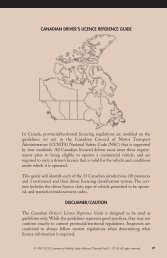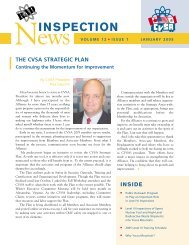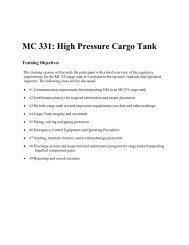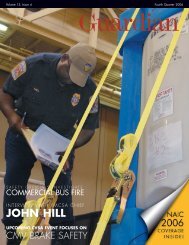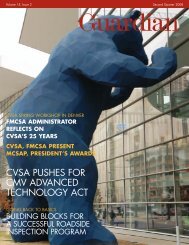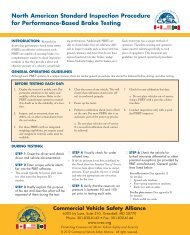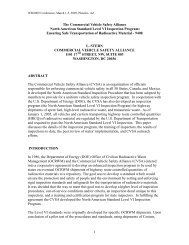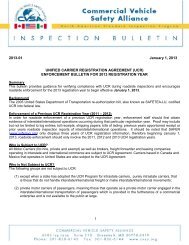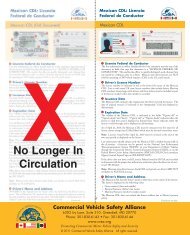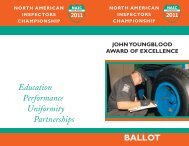inside cover - Commercial Vehicle Safety Alliance
inside cover - Commercial Vehicle Safety Alliance
inside cover - Commercial Vehicle Safety Alliance
You also want an ePaper? Increase the reach of your titles
YUMPU automatically turns print PDFs into web optimized ePapers that Google loves.
Guardian<br />
F E D E R A L N E W S<br />
Ask the Administrator<br />
Question: Where were you and<br />
what were you doing when CVSA<br />
was established<br />
John H. Hill: I spent 29 years with the<br />
Indiana State Police, and that’s where I<br />
was working when CVSA was created in<br />
1982. A few years later, Indiana joined<br />
the Motor Carrier <strong>Safety</strong> Assistance<br />
Program (MCSAP) and CVSA. Prior to<br />
joining MCSAP, Indiana’s CMV program<br />
lacked uniformity and was somewhat<br />
inconsistent in its enforcement<br />
activities. Joining CVSA and participating<br />
in MCSAP allowed the state to<br />
study, analyze and implement programs<br />
that benefited motor carrier oversight.<br />
In 1989, Indiana created a Motor<br />
Carrier Division within the State Police<br />
and named me its new commander. As a<br />
new division, we did not have a formal<br />
structure to follow from previous commanders,<br />
so my first action was to attend<br />
a CVSA meeting. I found the CVSA<br />
experience quite rewarding. I soon met<br />
with my counterparts across the country,<br />
learned how they structured their state<br />
programs and how to best structure ours.<br />
Question: What are your memories<br />
of CVSA’s growth and contributions<br />
to safety<br />
Hill: CVSA reinforced the importance<br />
of not only having a national standard for<br />
safety inspections of commercial motor<br />
vehicles, it created a forum for key players<br />
in enforcement, industry and related<br />
groups to regularly deliberate and<br />
approve policies that harmonized federal<br />
regulations with operational inspection<br />
activities. Prior to CVSA being formed,<br />
states did not have this opportunity. I<br />
also believe it helped provide federal regulators<br />
with valuable operational insights<br />
about the effectiveness of their regulatory<br />
efforts.<br />
Question: What are your aspirations/visions<br />
for CVSA in the<br />
future<br />
Hill: As the federal agency that oversees<br />
the interstate trucking and motorcoach<br />
industries, FMCSA has a very clear mandate<br />
to increase safety on American roads.<br />
CVSA also has safety as its chief priority.<br />
CVSA provides an international forum<br />
for improving CMV safety practices. In<br />
the future we need to expand our knowledge<br />
of safety efforts beyond North<br />
America and learn from other countries<br />
how best to address highway safety.<br />
CVSA can contribute in this aspect.<br />
FMCSA Announces Interim Final Rule on<br />
Hours-of-Service Regulation<br />
Truck drivers will continue to be limited<br />
to driving 11 hours within a 14-hour<br />
duty period, after which they must go<br />
off duty for at least 10 hours under an<br />
Interim Final Rule (IFR) made public in<br />
December by the Federal Motor Carrier<br />
<strong>Safety</strong> Administration. The IFR was<br />
developed after new data showed that<br />
safety levels have been maintained<br />
since the 11-hour driving limit was first<br />
implemented in 2003.<br />
“This proposal keeps in place hoursof-service<br />
limits that improve highway<br />
safety by ensuring that drivers are rested<br />
and ready to work,” FMCSA<br />
Administrator John H. Hill said. “The<br />
data makes clear that these rules continue<br />
to protect drivers, make our roads<br />
safer and keep our economy moving.”<br />
The agency noted that, in 2006, the<br />
fatality rate per 100 million vehicle<br />
miles traveled was 1.94 – the lowest<br />
rate ever recorded. Similarly, since<br />
2003, the percentage of large trucks<br />
involved in fatigue-related fatal crashes<br />
in the 11th hour of driving has<br />
remained below the average of the<br />
years 1991-2002. In 2005 alone, the<br />
agency noted, there was only one large<br />
truck involved in a fatigue-related fatal<br />
crash in the 11th hour of driving while<br />
in 2004 there were none.<br />
In addition, between 2003, when<br />
the 11-hour driving limit and the 34-<br />
hour restart were adopted, and 2006,<br />
the percent of fatigue-related large<br />
truck crashes relative to all fatal large<br />
truck crashes has remained consistent.<br />
And the agency’s estimates show that<br />
only seven percent of large truck crashes<br />
are fatigue related.<br />
Hill noted that the agency also is<br />
working to finalize a proposed rule<br />
that would require drivers and trucking<br />
companies with serious or repeat<br />
hours-of-service violations to track<br />
their hours of service using electronic<br />
on-board recorders.<br />
The agency issued the new hours of<br />
service rule in response to the recent<br />
decision by the D.C. Circuit Court of<br />
Appeals vacating key provisions of the<br />
existing hours of service rules effective<br />
on December 27. In order to ensure no<br />
gap in <strong>cover</strong>age of these safety rules,<br />
the IFR temporarily reinstates those<br />
two provisions while the agency gathers<br />
public comment on its actions and<br />
the underlying safety analysis before<br />
issuing a final rule.<br />
7



